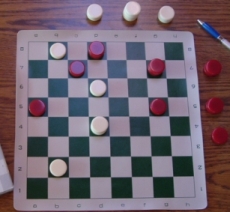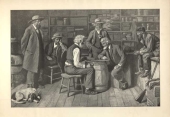The Checker Maven
The World's Most Widely Read Checkers and Draughts Publication
Bob Newell, Editor-in-Chief
Published every Saturday morning in Honolulu, Hawai`i
Noticing missing images? An explanation is here.
Carol Joy Cole: A Friend to the Checkers World
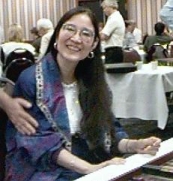
These have been fine items, though the "swirly" checkers are not strictly regulation, and the Danish checkers are a bit on the thin side. Now, Carol has improved her offerings by obtaining Roger Blaine's special order stock of genuine solid color Crisloid red and whites, in both 1.25 and 1.50 inch diameter sizes.
I splurged on both of these sets, and they are wonderful. The color and manufacture is uniform and the "feel" of the pieces is great. These are true regulation checkers, and an excellent value at $20 for the small and $30 for the large, plus $4 for shipping. Get them while they last! (Note: These are no longer listed in the catalog.)
Carol has gone out of her way to serve checker players, even though it's a small market and not likely to bring her much return. Carol is always helpful and courteous and ships promptly with no fuss or ado. Carol, on behalf of checker players everywhere, please accept our thanks!You can reach Carol through her web site, as linked above, or by email at cjc@tir.com.
Checker Hall of Fame to Close as Walker Resigns Positions

On January 11, Mississippi newspapers published this article about Walker's January 7 arrest and indictment on Federal money laundering charges. The charges are tied to a series of companies operated by Walker, including the International Checkers Hall of Fame.
Prominent checker personalities and officials have been quick to point out the outstanding contributions made over a period of decades by Mr. Walker to the game of checkers. He has been a tireless promoter and organizer and has worked hard on behalf of the checker-playing community.
The charges against Mr. Walker are serious indeed. But let's not forget that in America, a man is innocent until proven guilty. Mr. Walker deserves fair consideration and a fair trial. And no matter the outcome, his record of service to the checker world will always stand.
February 1, 2005 update: additional news stories can be found here.
News From the CSi BBS
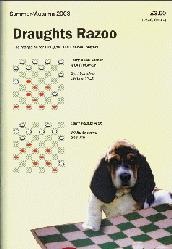
First, Martin Fierz has released a new version of CheckerBoard (click on the link to download). This release fixes and adds a few things, but mostly allows use of Hans L'Hoest's OCA database, a very large collection of checker games.
Checkerboard is surely one of the premiere checker interfaces available. We all owe Martin, big time, for developing, maintaining, and enhancing this fine software.
Second, Draughts Razoo, which to my knowledge is the only full-fledged checker print magazine (there are several newsletters), is discontinuing publication. The editor, Nick McBride, simply doesn't have the time any longer for such a major undertaking. 'Tis a pity. The days of my grandfather were filled with checker magazines and newspaper columns. Is there a single one left? Comment here if you know of any, for the benefit of us all.
Al Lyman, noted commentator, correspondence player, and checker educator, has proposed a monthly on-line magazine. This would be a "complete" magazine going well beyond an episodical blog such as The Checker Maven. Al is certainly well-qualified to do this and I wish him success. It's a lot of work; don't I know it! Keeping up The Checker Maven is effort enough, but a full monthly magazine will require concerted effort and a lot of help. I hope it works out and enriches the checker world thereby.
The Numbered Board and Move Notation
To follow the play presented in The Checker Maven you need to understand the numbered board and checker move notation.
With Black at the top, White at the bottom, the board is numbered in rows from left to right and top to bottom.
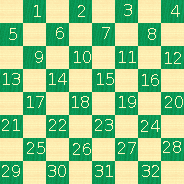
WHITE
With White at the top, Black at the bottom, the board is numbered in rows from right to left and bottom to top.
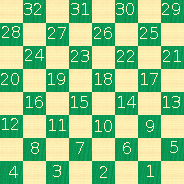
BLACK
These two numbering schemes are of course really the same thing; you are just looking at them from opposite sides.
A move is shown by listing the "from" and "to" square with a dash between them. For instance, 11-15 is the most popular Black starting move; Black moves the man on square 11 to square 15. 22-18 in reply forms the famous "Single Corner" opening; White moves the man on square 22 to square 18.
Captures are shown in the same way. Sometimes a dash is still used, sometimes an x. So continuing our game, Black jumps 15-22 or 15x22 if you prefer; Black jumps the man on 15 over to square 22 (capturing the White man on 18).
Multiple jumps, such as a double or triple jump, require you to pay attention, as the convention is to just show the start and end squares and not the in-between or intermediate squares. So the notation 1-3 would mean a King does a double jump from 1 to 10 to 3. The intermediate square is only shown if there are two ways to jump and it would not be clear otherwise.
In practice this is all very much easier than you might think, and you can learn the numbers with a couple of hours of practice. Some people prefer using numbered diagrams or a numbered board as a "helper." It's your choice, but we feel in the long run you are better off taking the time to learn the numbers, and avoiding long-term reliance on numbered boards and diagrams. Really, it's a piece of cake.![]()

The Checker Maven is produced at editorial offices in Honolulu, Hawai`i, as a completely non-commercial public service from which no income is obtained or sought. Original material is Copyright © 2004-2025 Avi Gobbler Publishing. Other material is public domain, AI generated, as attributed, or licensed under CC1, CC2,CC3 or CC4. Information presented on this site is offered as-is, at no cost, and bears no express or implied warranty as to accuracy or usability. You agree that you use such information entirely at your own risk. No liabilities of any kind under any legal theory whatsoever are accepted. The Checker Maven is dedicated to the memory of Mr. Bob Newell, Sr.
